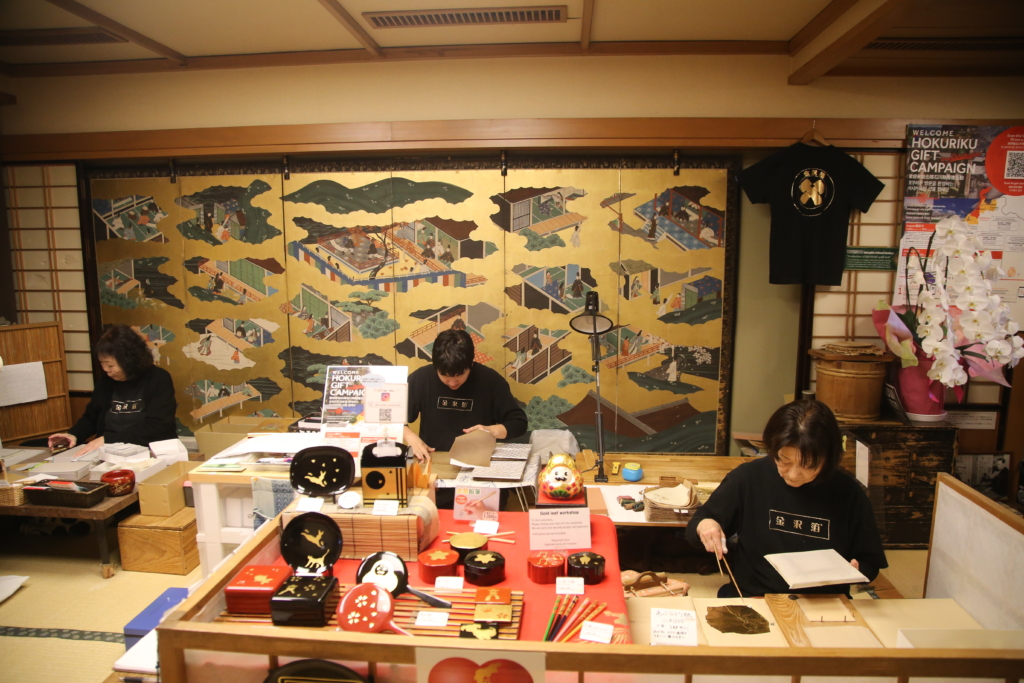
Kanazawa Gold Leaf: A Tradition of 400 Years The Craftsmanship that Preserves Its Gleaming Technique
Kanazawa City, located in Ishikawa Prefecture, is a city of history and craftsmanship that continues to convey the culture of Kaga Hyakumangoku. Among its many traditions, “gold leaf” stands as a symbol of the city. The gold leaf produced in Kanazawa accounts for nearly 100% of domestic production and is indispensable in important cultural properties and traditional crafts. While preserving the history of Kanazawa gold leaf, there are artisans working to create new value for modern life. One such artisan is Mr. Teramoto, who works at Gold Leaf Sakuda, a company with over 100 years of history. This article explores the life of a craftsman living between tradition and innovation.
The History of Gold Leaf Nurtured by the Kaga Hyakumangoku
With the opening of the Hokuriku Shinkansen, access to Kanazawa has dramatically improved, making it a historically rich tourist destination known as the castle town of Kaga Hyakumangoku. The city is filled with scenic spots such as Kenrokuen Garden, Kanazawa Castle Park, and Higashi Chaya District, where the spirit of Japanese traditional crafts is alive and well throughout the town.
Kanazawa is a major gold leaf production center and is known as the “City of Gold Leaf.” The history of gold leaf dates back over 400 years, beginning in the Edo period when Maeda Toshiie, the first lord of the Kaga Domain, ordered the production of gold leaf. Under his directive, artisans honed their unique techniques, and by the Edo period, gold leaf production had become an important industry for the Kaga Domain. Despite restrictions from the Shogunate, the techniques were passed down and continued as a local industry in Kanazawa.
Furthermore, Kanazawa’s humid climate is ideal for the preparation of the washi paper used in gold leaf production, playing a crucial role in enhancing the quality of the “haku-uchi gami” (foil stamping paper) essential for the process. The region’s soft water quality is another reason why Kanazawa is well-suited for gold leaf production. These natural conditions have supported Kanazawa’s reputation as the “City of Gold Leaf.”
The gold leaf produced in Kanazawa is used in significant cultural properties such as Kinkaku-ji, Nikko Toshogu Shrine, and Chūson-ji, and its high quality and craftsmanship are admired worldwide. The gold leaf known as “Kanazawa Haku” has evolved over many years, with various techniques being added, achieving a fusion of tradition and innovation.
Amidst this background, Gold Leaf Sakuda, a company with over 100 years of history, has worked to preserve and foster gold leaf culture in the region. The artisans at Gold Leaf Sakuda not only inherit the manufacturing techniques but also continue to take on new challenges every day.
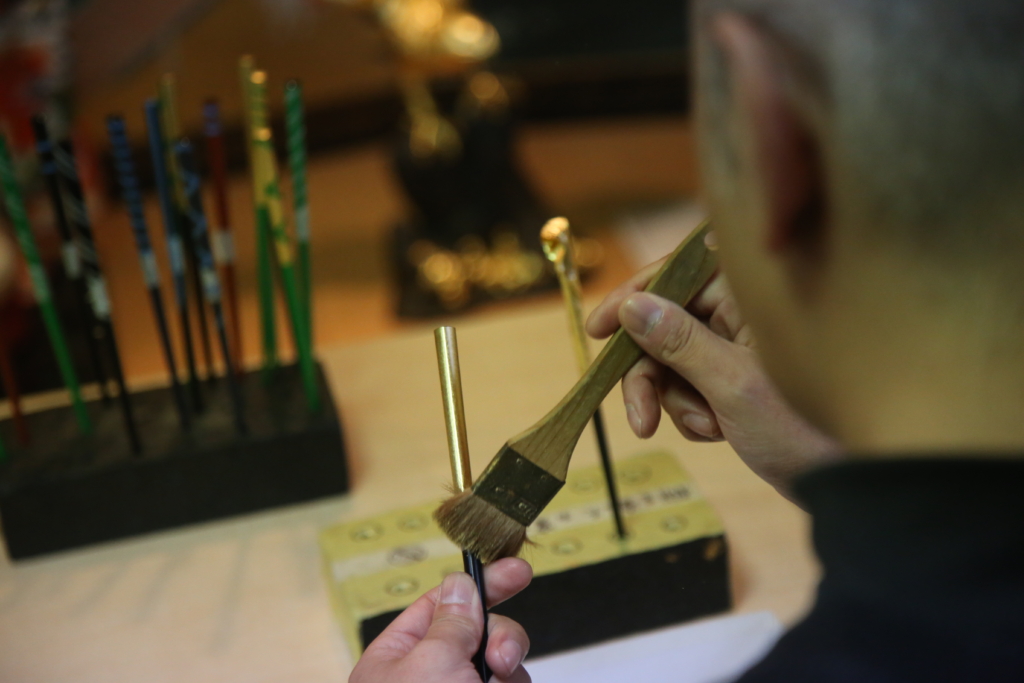
Gold Leaf Sakuda, the Bearer of Gold Leaf Culture with Over 100 Years of History
Gold Leaf Sakuda was founded in 1919 as a gold leaf manufacturing company. Over time, it expanded into a wholesaler, supplying gold leaf to industries such as the Buddhist altar and craft sectors across the country. Around 1980, the company began creating gold leaf craft items. They worked on gold leaf lacquerware, applying gold leaf to Yamanaka lacquerware, and later branched out into creating items using various materials such as glass, fabric, and copper. Gold Leaf Sakuda has also collaborated on products with traditional crafts from across Japan, gaining recognition both domestically and internationally as a symbol of Kanazawa, the “City of Gold Leaf.”
The main store, located near the Higashi Chaya District, offers visitors a chance to experience the charm of gold leaf through guided tours of the manufacturing process, hands-on gold leaf application experiences, and displays at a mini museum. It is a popular destination for tourists, welcoming visitors from 80 to 90 countries annually, and is beloved as a place that embodies the culture and tradition of Kanazawa.
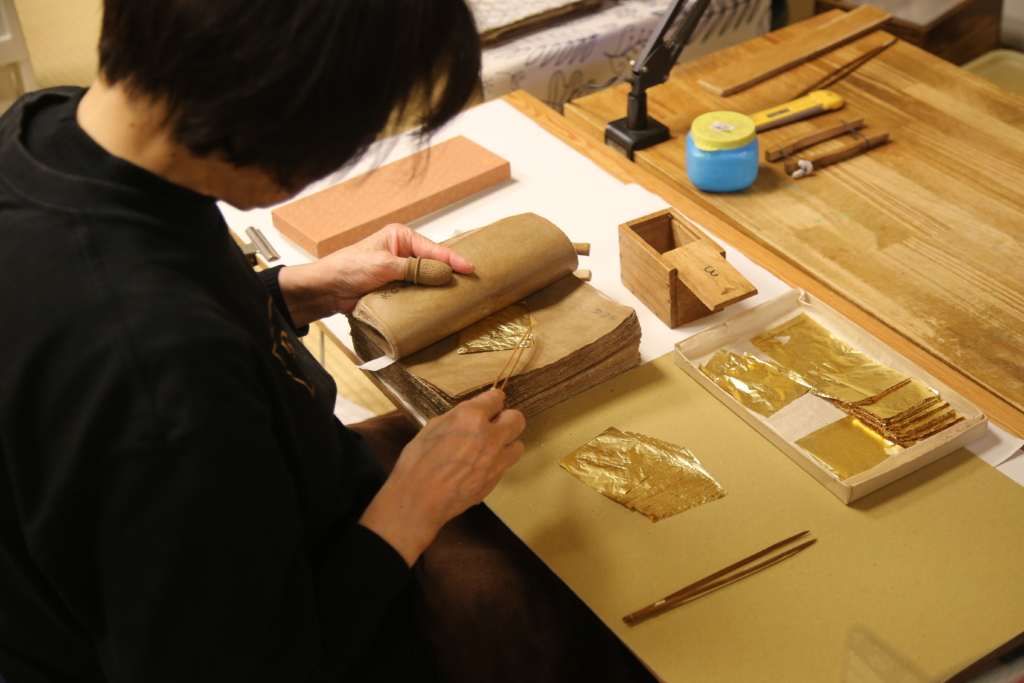
From Home-based Industry to Gold Leaf Production Complex
“Gold leaf manufacturing was originally a home-based industry,” says Mr. Teramoto. In Kanazawa, it was common for families to produce gold leaf in ordinary houses along rivers. The river water was essential for preparing the washi paper, so naturally, families involved in gold leaf production gathered along the riversides in Kanazawa.
However, noise from the machinery used in the manufacturing process began to impact on the local community, leading to the establishment of a “gold leaf complex” in Fukuku Town several decades ago. In this complex, gold leaf artisans gathered, and production continues there today. “By gathering the workshops in one area, the noise issue was mitigated, and it became easier for artisans to interact with each other,” says Mr. Teramoto.
Gold leaf production is divided into two main processes. The first is the “Kaneawase” process, where gold is mixed with other metals to create an alloy, and the “Zumi” process, which involves thinning the metal to 0.002 to 0.003 millimeters. The second process is the “Hakoya” process, where the metal is stretched further to a thickness of 0.0001 millimeters.
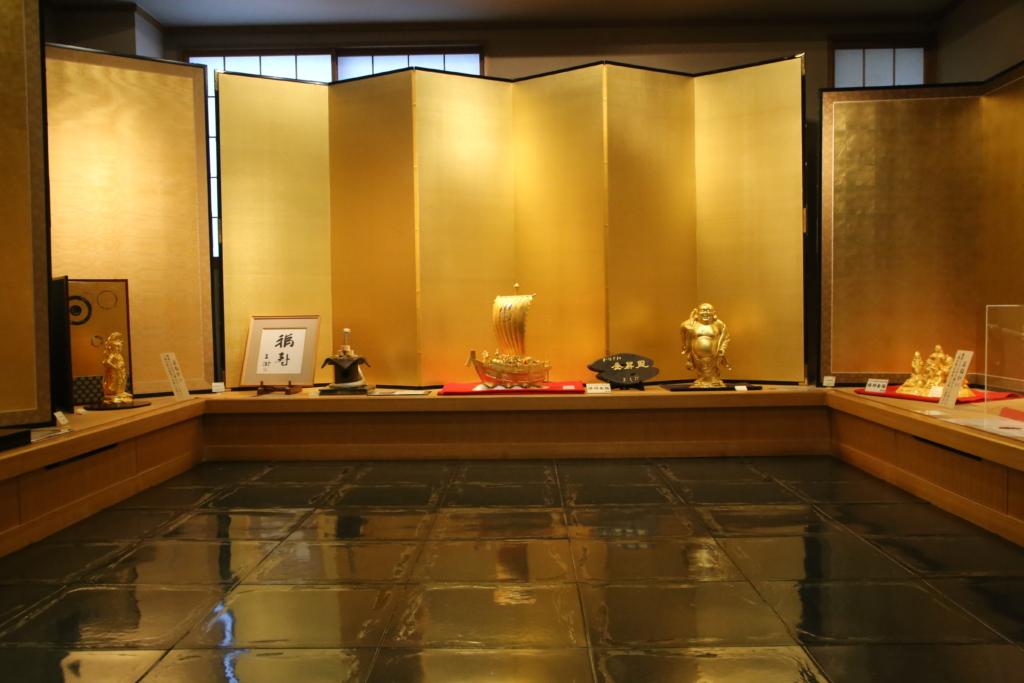
The Art of Preparing Washi Paper, Essential for Gold Leaf Craftsmanship
The most important material in gold leaf production is specially prepared washi paper. This washi is not just a basic material, but a crucial element that determines the quality of the gold leaf, as Mr. Teramoto explains. “It’s not an exaggeration to say that the quality of the washi paper directly affects the quality of the gold leaf. It’s that important,” he emphasizes.
The washi paper used specifically for gold leaf production is made from a rare material called “Gampi.” However, today, the only supplier is from Najio, Hyogo Prefecture, and its production is limited. In the past, Gampi was also produced in Ishikawa Prefecture, but due to a decrease in demand and a shortage of artisans, production ceased in recent years. Currently, production is only continuing in Hyogo Prefecture. This situation is one of the major challenges in gold leaf manufacturing.
Washi paper, in its natural state, is not suitable for gold leaf production. Mr. Teramoto explains, “We use washi made by mixing special mud with Gampi washi paper. The paper then undergoes a process to prepare it in a form suitable for gold leaf beating.” This process requires the utmost care, as even slight differences in the steps can have a significant impact on the final quality of the gold leaf.
The prepared washi paper is then placed between the layers of gold leaf, and by repeatedly pounding it, the gold is spread thin. Any slight variation in pressure or impact can cause the gold leaf to tear or become uneven, which is why the skill of the artisan is essential.
Mr. Teramoto says, “It takes many failures before you finally master this technique. It’s not just about making the paper thin, but achieving an even finish, which is truly difficult. It takes at least ten years to become a skilled artisan.” His words reflect the pride and responsibility that artisans carry in maintaining this tradition.
Thus, the preparation of washi paper forms the foundation of gold leaf production, and its success or failure ultimately determines the value of the final product. The rare material, meticulous technique, and accumulated experience come together to create Kanazawa’s world-renowned gold leaf.
Motivation Driven by Interactions with People
Mr. Teramoto first entered the world of gold leaf 35 years ago. “After graduating from high school, I worked for a company, but something felt off, so I quit after about two years,” he recalls. He then approached Gold Leaf Sakuda, which had been a familiar part of his life since childhood and asked for a chance. Since then, he has continued the path of an artisan.
One of the most memorable experiences in his career was teaching the experience of gold leaf application to Prince and Princess Akishino. “I was in charge of a gold leaf application experience at the Lifelong Learning Festival held in Ishikawa Prefecture. Both showed great interest, asking detailed questions, like what kind of adhesive we use. I still remember that conversation clearly,” he says with a smile.
Additionally, when guiding tourists through hands-on experiences, Mr. Teramoto shares, “It makes me happy to see the smiles on the customers’ faces. Some foreign visitors even buy expensive items on the spot, which gives me a sense of fulfillment as an artisan.”
New Initiatives Expanding the Possibilities of Gold Leaf
Mr. Teramoto is also interested in using gold leaf techniques for the restoration of cultural heritage and collaboration projects. In recent years, collaborative production with traditional crafts from across Japan has been advancing. “Gold leaf is not just a product, but a material with infinite possibilities,” he says. He has been involved in collaborative projects with traditional crafts such as Iwate Prefecture’s Nambu ironware and Ehime Prefecture’s Iyo Ittō carving, expanding his efforts to connect with artisans nationwide.
Mr. Teramoto takes great pride in the fact that Kanazawa’s gold leaf is used in national treasures and cultural properties. The gold leaf on Kinkaku-ji and Nikko Toshogu Shrine were all produced in Kanazawa. “Being involved with such historical buildings is a great source of fulfillment as an artisan,” he says.
The applications of gold leaf continue to expand. It is not only used in the restoration of important cultural properties and historical buildings but also in crafts, cosmetics, and food decoration, playing a role in various aspects of modern life. Gold leaf is gaining attention in the cosmetics industry for its blood circulation-promoting effects and antioxidant properties.
Kanazawa’s gold leaf is widely exported not only within Japan but also to countries such as South Korea, Taiwan, and various European nations. Even today, the demand for gold leaf continues to rise, and Kanazawa’s gold leaf is highly regarded worldwide for its quality and craftsmanship. “I’m happy that the charm of gold leaf is being recognized not just in Japan but around the world,” says Mr. Teramoto.
The Pride and Affection of an Artisan Living in Kanazawa
For Mr. Teramoto, Kanazawa is not just his hometown, but a special place deeply connected to his life. He feels a strong sense of pride and affection for the city, with its rich history of Kaga Hyakumangoku and the many traditional crafts that are part of Japan’s heritage. At the same time, he admits to feeling a slight sense of sadness as the city becomes more commercialized and its landscape changes. “In the past, it was quieter, and the daily lives of the locals were more evident,” he says. Despite these changes, he remains positive and looks forward to the future.
While preserving the tradition of gold leaf, Mr. Teramoto continues to respond to the needs of the new era. His efforts will likely become a driving force for Kanazawa to shine even more brightly in the future. And this radiance will undoubtedly captivate people’s hearts and serve as a bridge to pass on the region’s culture to the next generation.
Kenichi Teramoto
Born in Kanazawa City, Ishikawa Prefecture. After graduating from high school, he started working at a company, but driven by a passion for craftsmanship, he ventured into the world of gold leaf production. Enchanted by the culture of gold leaf, which has deep roots in the Kanazawa area, he began training at the local gold leaf company, Gold Leaf Sakuda. Over the course of more than 35 years, he has built a career as an artisan. Today, in addition to his work in production, he is actively involved in guiding tourists through hands-on experiences and promoting traditional crafts.
As a key figure supporting Kanazawa’s traditional crafts, he continues to engage in community-based activities.
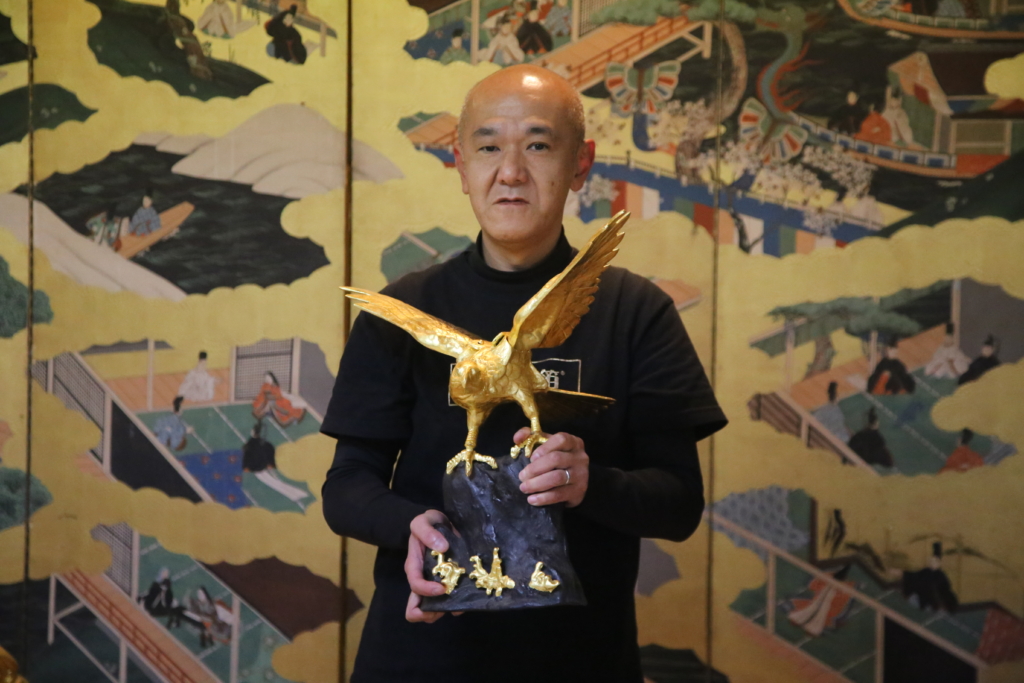
If you would like to visit Kinpaku Sakuda and get further into the world of Kanazawa gold leaf, please see the following information
Kanazawa’s representative traditional craft
Gold leaf application experience at Sakuda, a gold and silver leaf craftsman
Highlights
・You can try gold leafing using 1/10,000 mm gold leaf.
・You can observe the craftsmen at work right in front of you.
Information
Fee: 1,000-2,400 yen per person
You can choose from chopsticks, round plates, small boxes and hand mirrors.
Participants: up to 30 people
Time required: approximately 1 hour
Duration: about 1 hour
Included: Gold leaf application and materials
Meet at: Sakuda Gold Leaf Shop, Main Store
Language: Japanese (English interpreter can be arranged upon request)
For reservation inquiries, please click here.